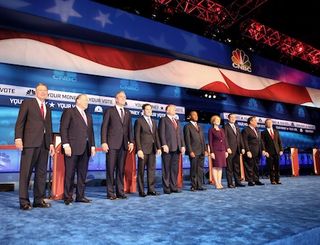Guest Blog: Inside the Fine Art of Political Ad Persuasion

The last two presidential elections were groundbreaking in their use of digital media. So much has evolved since then, and campaign advertisers now have more opportunities than ever to reach the right voters at the right time and on the right device. While TV may still be the medium of choice for campaign advertising, data-powered digital can now identify and reach discrete audiences at scale in an efficient, cost-effective and measurable way. For the first time, campaigners can focus on reaching individuals rather than households via channels such as social and mobile.
Along with that promise, however, comes many challenges. Reaching fragmented audiences across channels and devices is clearly possible, but not easy. How can a campaign marketer tell whether a voter is a Bernie Sanders Democrat or a Donald Trump Republican? How can data identify these unique voter types and help marketers engage with them across screens?
This is actually where traditional, publicly available voter data is of limited use. However, it's also where third-party data can be most helpful. In the case of the Trump Republican, there is a lot we know from polling data. For example, we know that his supporters tend to be white males who generally do not have a university education. Publicly available donor data tells us that Sanders' supporters are likely to be female, from cities including Portland, Ore.; Burlington, Vt. or Seattle; and given his stance on climate change, they're also likely to be environmentalists. Additional available data, merged with polling data, voter data and third-party data from sources like credit card companies can help each campaign build models that help identify and reach similar voters throughout the digital universe. Using that data to fuel a cross-channel programmatic advertising campaign represents the best way to scale a targeted, efficient campaign.
It's important to note that the message transcends the medium for Trump and Sanders. With their strong, passionate, and unconventional personae and unique approach to politics, they are themselves disrupters. They do not fit the mold of traditional politics and, in the case of Trump, haven't yet felt the need to invest in advertising at this point. Yet, they've tapped into something that's happening in this country, and political marketers should take heed. The smart approach to this election will not only rely on how voter files are leveraged to improve turnout, it will be about looking hard at the country and questioning how people feel. It will involve a deeper dive into why Trump and Sanders are fascinating American voters today.
Data can help identify unique voter audiences and get to the heart of their interests and concerns, which makes digital an even more critical channel for this election. Where Trump and Sanders are attracting nontraditional voters, there are many who fall outside that classification, and they're as varied in their demographics and interests as Americans can be. That's an advantage for marketers, who can leverage differences to win voters over. An Asian-American, for example, may respond more positively to a political ad when the message is delivered by an Asian spokesperson, and even more so if the message addresses issues specific to that population. In crowded bedroom communities, long commutes due to highway congestion may be an important issue, so issues addressing infrastructure may resonate. Parents of young children are likely to respond positively to messages that address improving schools or family healthcare.
All of these population segments can be identified with data, and every bit of it matters. Homeowners will have different concerns than renters, and seniors will care about things that will not concern young couples. Yet each population will be passionate about something, and campaign marketers can use that passion to engage and potentially win undecided voters, or to ignite ambassadors within the party.
Once voters have been engaged, frequency and recall become the important metrics to optimize. We know that when an ad is seen in multiple places, the likelihood of recall improves. Political marketers rely on that "burn in" to ensure voters remember their messages once they are in line at the polls. Reaching voters across screens creates more opportunities for both frequency and effectiveness. When voters see a campaign ad on TV, and then see that message again on their mobile or computer screen, they are 53 percent more likely to recall that ad than just seeing it on TV alone. This is especially critical because not only is television inventory limited, but also because digital can be so much more effective at reaching voters in the places where they're already consuming content. Considering the literally billions of impressions available across addressable media at any given moment, marketers investing in programmatic advertising ensure themselves the best opportunity to "burn in."
The final hurdle is that the digital advertising ecosystem offers few holistic solutions, so campaign professionals need to find knowledgeable and trustworthy partners whose goals align with theirs. Additionally, it is critical to be sure their technology is powerful and nimble enough to support those goals. Political marketers also need to determine the right media mix and how to efficiently allocate funds to maximize reach into their target voter audience. But again, this is where marketers must rely on their partners to test and optimize throughout the campaign cycle.
As campaign advertising begins shifting more funds and attention from TV to digital, there's a lot to learn. However, the learning process itself is exciting, and 2016 is proving to be the perfect canvas for the programmatic campaign.
Peter Pasi is vice president, political sales, at the ad network Collective.
Broadcasting & Cable Newsletter
The smarter way to stay on top of broadcasting and cable industry. Sign up below
